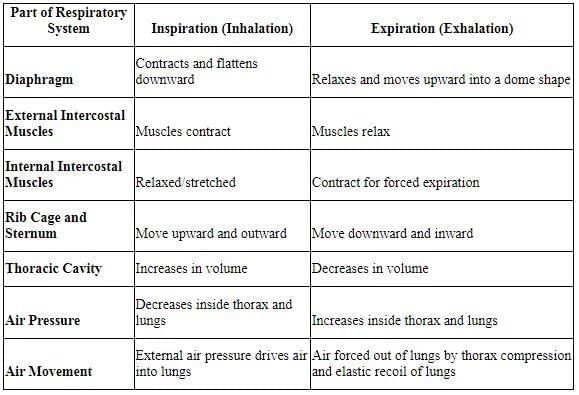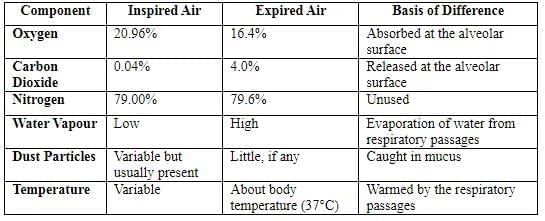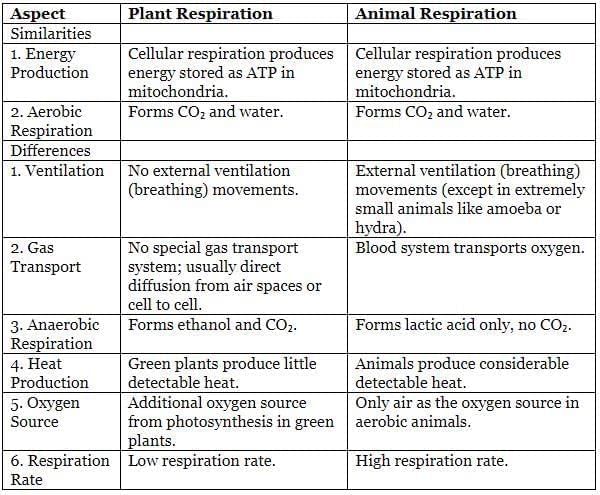Respiratory System Chapter Notes | Biology for SSS 2 PDF Download
Introduction
Respiration is a crucial process for all living organisms, enabling the release of energy needed for various life activities. This chapter explores the respiratory system in humans, detailing the organs involved, the mechanism of breathing, and the chemical processes of cellular respiration. It also covers differences between aerobic and anaerobic respiration, the role of muscles in breathing, and the effects of altitude on respiration. Additionally, experiments demonstrating breathing and respiration processes are included to provide a practical understanding of the concepts.
The Need for Respiration
Respiration is a chemical process that breaks down glucose to release energy for life activities.
Chemical equation: C₆H₁₂O₆ + 6O₂ → 6CO₂ + 6H₂O + energy.
Key points about the respiration reaction:
- Occurs inside cells, known as cellular or tissue respiration.
- Glucose breakdown happens in multiple chemical steps in cytoplasm and mitochondria.
- Each step is catalyzed by specific enzymes.
- Energy is stored as ATP (adenosine triphosphate), the cell's energy currency.
- One mole of glucose produces 38 ATP molecules upon complete oxidation.
- Cellular respiration steps are similar in plants and animals.
Energy is needed for:
- Building proteins from amino acids.
- Producing enzymes.
- Muscle contraction for movement.
- Conducting nerve impulses.
- Cell division for growth.
- Maintaining body warmth in birds and mammals.
Animals Need More Energy
Animals require more energy than plants due to physical activities like:
- Moving to find food or escape predators.
- Chewing food.
- Caring for eggs or young ones.
Birds and mammals need extra energy to produce heat for maintaining body temperature, especially in cold environments. Liver and muscle cells generate significant heat, with shivering producing extra heat during extreme cold.
Glucose Has No Alternative for Respiration
- Glucose is the primary molecule used for respiration.
- If glucose is unavailable, cells can break down proteins or fats to produce glucose.
- In carnivorous animals, excess amino acids from protein digestion are converted into glucose in the liver, with nitrogenous waste excreted as urea.
- Glucose can be used immediately or stored as glycogen in the liver for later use.
Two Kinds of Respiration: Aerobic and Anaerobic
- Aerobic respiration uses oxygen and is common in animals.
- Anaerobic respiration occurs without oxygen, e.g., in tapeworms or during intense muscle activity.
- Aerobic respiration equation: C₆H₁₂O₆ + 6O₂ → 6CO₂ + 6H₂O + 38 ATP + 420 kcal heat.
Chemical Steps in Respiration
- Anaerobic respiration in animals:
- Occurs in skeletal muscles during intense exercise with low oxygen.
- Produces lactic acid, causing fatigue (oxygen debt).
- Equation: C₆H₁₂O₆ → lactic acid + 2 ATP + heat.
- Key points:
- Slow process.
- Lactic acid is toxic, causing muscle fatigue.
- No CO₂ is produced.
- Releases less energy than aerobic respiration.
Differences in anaerobic respiration:
- Plants: Produces ethanol and CO₂, more heat, causes foaming due to CO₂.
- Animals: Produces lactic acid, no CO₂, less heat, no foaming.
Parts of Respiration
Four major parts in humans:
- Breathing: Physical process of inhaling and exhaling air through the lungs.
- Gaseous transport: Oxygen is carried by red blood cells (RBCs) as oxyhaemoglobin via arteries; CO₂ is transported to lungs via veins as bicarbonates or carbamino-haemoglobin.
- Tissue respiration: Oxygen diffuses from capillaries to body cells, and CO₂ is collected from cells.
- Cellular respiration: Chemical breakdown of glucose inside cells to release energy.
Cellular respiration occurs in:
- Cytoplasm (Glycolysis)
- Breaks down glucose into pyruvic acid.
- Anaerobic process, no oxygen required.
- Produces little energy.
- In plants, pyruvic acid forms ethanol; in animals, it forms lactic acid.
Mitochondria (Krebs cycle):
- Requires oxygen.
- Breaks down pyruvic/lactic acid to produce ATP, CO₂, and water.
- Removes H⁺ ions by combining with oxygen to form water.
- Produces significant energy.
Respiratory Organs (Breathing)
Human respiratory system includes air passages (nose, pharynx, larynx, trachea, bronchi) and lungs.
Nose:
- Has two nostrils separated by a cartilaginous septum.
- Hairs filter large particles.
- Nasal chambers warm, moisten, and filter air with mucus.
- Contains sensory cells for smell in a special pocket.
- Nose aids in speech (try speaking with nose closed).
Pharynx:
- Common passage for air and food.
- Leads to trachea (air) and oesophagus (food).
- Epiglottis prevents food from entering trachea; incomplete closure causes coughing.
Larynx (voice box):
- Hollow cartilaginous structure at the start of the trachea.
- Contains vocal cords that vibrate to produce sound.
- Sound pitch adjusted by vocal cord tension and distance.
- Speech involves lips, cheeks, tongue, and jaws; unique to humans.
Trachea (windpipe):
- Supported by C-shaped cartilage rings for flexibility and to prevent collapse.
- Partly covered by thyroid gland.
Bronchi:
- Trachea splits into two bronchi, each entering a lung.
- Divide into secondary and tertiary bronchi, then into bronchioles.
Lungs:
- Spongy, elastic organs with air sacs (alveoli), bronchioles, and blood vessels.
- Left lung: 2 lobes; right lung: 3 lobes.
- Covered by visceral and parietal pleura with pleural fluid for lubrication.
- Located in thoracic cavity, resting on diaphragm.
Blood supply:
- Right ventricle pumps deoxygenated blood to lungs via pulmonary artery.
- Artery branches into capillaries around alveoli.
- Oxygenated blood returns to left auricle via pulmonary veins.
Trachea lining:
- Contains ciliated and mucus-secreting cells.
- Cilia move mucus and trapped particles toward the mouth.
Breathing - Respiratory Cycle
- Breathing is the mechanical process of inhaling and exhaling air, part of respiration.
- Respiratory cycle: Inspiration, expiration, and a brief pause.
- Normal breathing rate: 12–18 breaths/min (adults), 60 breaths/min (newborns).
Inspiration:
- Thoracic cavity enlarges due to rib movement (external intercostal muscles contract) and diaphragm flattening.
- Lowers lung pressure, drawing air in.
Expiration:
- Ribs move inward (external intercostal muscles relax), diaphragm returns to dome shape.
- Thoracic cavity shrinks, increasing lung pressure, forcing air out.
- Forced expiration involves internal intercostal muscles.
Control of Breathing Movements
Breathing is primarily regulated by the respiratory center in the medulla oblongata of the brain, which responds to the carbon dioxide levels in the blood. Higher carbon dioxide levels accelerate breathing. Typically, breathing is involuntary, beyond conscious control, though individuals can temporarily adjust its rate and depth. However, when holding the breath voluntarily, a point is reached where the urge to breathe becomes irresistible.
Breathing Movements in Humans

Capacities of the Lungs
Respiratory volumes in a normal adult:
- Tidal volume: 500 mL (air in/out during normal breathing).
- Dead air space: 150 mL (air in trachea/bronchi, no gas exchange).
- Alveolar air: 350 mL (tidal air in alveoli).
- Inspiratory reserve volume: 3000 mL (extra air inhaled forcibly).
- Inspiratory capacity: 3500 mL (tidal + inspiratory reserve).
- Expiratory reserve volume: 1000 mL (extra air exhaled forcibly).
- Vital capacity: 4500 mL (maximum air in/out during forced breathing).
- Residual volume: 1500 mL (air remaining after forced exhalation).
- Total lung capacity: 6000 mL (maximum air lungs can hold).
Inspired Air vs. Expired Air
The air within the lungs is never fully replaced; it is a blend of residual air and newly inspired air. With each cycle of inspiration and expiration, the air quality in the lungs fluctuates, becoming richer or poorer in certain components.
Differences in Quality Between Inspired and Expired Air:
- Oxygen Content: Expired air contains less oxygen due to absorption at the alveolar surface.
- Carbon Dioxide Content: Expired air has more carbon dioxide, released from the blood at the alveoli.
- Water Vapour: Expired air has higher water vapour content due to evaporation from the respiratory passages.
- Temperature: Expired air is warmer, typically reaching body temperature (37°C), as it is heated by the respiratory passages.
- Bacteria: Expired air may contain some bacteria, unlike inspired air, which is generally filtered by the respiratory system.
Average Composition of Inspired and Expired Air

Effect of Altitude on Breathing
As altitude increases, the air pressure decreases, resulting in a gradual reduction in oxygen availability. At approximately 4,500 meters above sea level, individuals may experience altitude sickness due to insufficient oxygen. Symptoms include dizziness, blurred vision, hearing loss, impaired muscular coordination, and, in severe cases, complete blackouts.
Hypoxia and Asphyxiation
- Hypoxia: Lack of oxygen reaching tissues, caused by poor ventilation or high altitudes.
- Asphyxiation: Increased CO₂ and reduced oxygen in blood, caused by strangulation, drowning, or airway obstruction; can be fatal if untreated.
- Artificial respiration may help in some cases.
Some Experiments on Breathing and Respiration
Water loss in breathing:
- Breathe on a cold surface (glass/slate); water droplets show moisture in expired air.
CO₂ in expired air:
- Use apparatus with lime water in two flasks.
- Inhale through one flask, exhale through another; lime water in exhale flask turns milky faster, proving more CO₂ in expired air.
Diaphragm action:
- Use a bell jar with a rubber sheet (diaphragm) and balloons (lungs).
- Pull sheet down: volume increases, balloons expand (inhalation).
- Push sheet up: volume decreases, balloons collapse (exhalation).
Volume of expired air:
- Blow air into a tube to displace water; measure displaced water to find exhaled air volume.
Oxygen use in respiration:
- Place a live cockroach in one flask and a dead one in another.
- Introduce a burning candle; flame extinguishes faster in the live cockroach flask, showing oxygen consumption.
Comparison of respiration in plants and animals

Points to Remember
- Respiration breaks down glucose to release energy for life processes.
- Glucose breakdown occurs in cytoplasm (glycolysis) and mitochondria (Krebs cycle).
- Aerobic respiration: C₆H₁₂O₆ + 6O₂ → 6CO₂ + 6H₂O + 38 ATP + 420 kcal.
- Anaerobic respiration in animals: C₆H₁₂O₆ → lactic acid + 2 ATP + heat.
- Human respiration includes breathing, gaseous transport, tissue respiration, and cellular respiration.
- Respiratory system: nose, pharynx, larynx, trachea, bronchi, lungs.
- Trachea has C-shaped cartilage rings to stay open.
- Lungs are spongy, elastic, with pleural membranes for lubrication.
- Inspiration: Ribs move up/out, diaphragm flattens; expiration: reverse movements.
- Lung capacities: Tidal (500 mL), inspiratory reserve (3000 mL), inspiratory capacity (3500 mL), expiratory reserve (1000 mL), vital capacity (4500 mL), residual (1500 mL), total lung capacity (6000 mL).
|
76 docs|10 tests
|
FAQs on Respiratory System Chapter Notes - Biology for SSS 2
| 1. What is the importance of respiration in animals? |  |
| 2. What are the two main types of respiration? |  |
| 3. How do respiratory organs function in the breathing process? |  |
| 4. What is the difference between inspired air and expired air? |  |
| 5. What are the capacities of the lungs, and why are they important? |  |
















